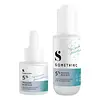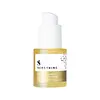What's inside
What's inside
 Key Ingredients
Key Ingredients

 Benefits
Benefits

 Ingredients Side-by-side
Ingredients Side-by-side

Rosa Damascena Flower Water 48%
MaskingGlycerin
HumectantNiacinamide 5%
SmoothingWater
Skin ConditioningMethylpropanediol
SolventSodium PCA
HumectantBetaine
Humectant1,2-Hexanediol
Skin ConditioningZinc PCA
HumectantAmmonium Acryloyldimethyltaurate/Vp Copolymer
Butylene Glycol
HumectantSodium Lauroyl Lactylate
EmulsifyingPentylene Glycol
Skin ConditioningXanthan Gum
EmulsifyingAdenosine
Skin ConditioningOctanediol
Ethylhexylglycerin
Skin ConditioningCeramide NP
Skin ConditioningHydrolyzed Algae Extract
Skin ConditioningAnthemis Nobilis Flower Extract
MaskingCeramide AP
Skin ConditioningPhytosphingosine
Skin ConditioningCholesterol
EmollientCarbomer
Emulsion StabilisingBeta Vulgaris Root Extract
Skin ConditioningAllantoin
Skin ConditioningCaffeine
Skin ConditioningCeramide EOP
Skin ConditioningTocopherol
AntioxidantRosa Damascena Flower Water 48%, Glycerin, Niacinamide 5%, Water, Methylpropanediol, Sodium PCA, Betaine, 1,2-Hexanediol, Zinc PCA, Ammonium Acryloyldimethyltaurate/Vp Copolymer, Butylene Glycol, Sodium Lauroyl Lactylate, Pentylene Glycol, Xanthan Gum, Adenosine, Octanediol, Ethylhexylglycerin, Ceramide NP, Hydrolyzed Algae Extract, Anthemis Nobilis Flower Extract, Ceramide AP, Phytosphingosine, Cholesterol, Carbomer, Beta Vulgaris Root Extract, Allantoin, Caffeine, Ceramide EOP, Tocopherol
Propolis Extract
Skin ConditioningMethylpropanediol
SolventCamellia Sinensis Leaf Extract
AntimicrobialWater
Skin Conditioning1,2-Hexanediol
Skin ConditioningOryza Sativa Bran Water
MaskingButylene Glycol
HumectantAmmonium Acryloyldimethyltaurate/Vp Copolymer
Betaine
HumectantHoney Extract
HumectantXanthan Gum
EmulsifyingGlycyrrhiza Uralensis Root Extract
Skin ConditioningEthylhexylglycerin
Skin ConditioningAdenosine
Skin ConditioningPhenoxyethanol
PreservativeMelia Azadirachta Flower Extract
Skin ConditioningMelia Azadirachta Leaf Extract
Skin ConditioningCurcuma Longa Root Extract
MaskingOcimum Basilicum Flower/Leaf Extract
TonicLawsonia Inermis Flower/Fruit/Leaf Extract
MaskingOcimum Sanctum Leaf Extract
Skin ConditioningCorallina Officinalis Extract
Skin ConditioningAllantoin
Skin ConditioningBee Venom
AstringentTocopherol
AntioxidantPropolis Extract, Methylpropanediol, Camellia Sinensis Leaf Extract, Water, 1,2-Hexanediol, Oryza Sativa Bran Water, Butylene Glycol, Ammonium Acryloyldimethyltaurate/Vp Copolymer, Betaine, Honey Extract, Xanthan Gum, Glycyrrhiza Uralensis Root Extract, Ethylhexylglycerin, Adenosine, Phenoxyethanol, Melia Azadirachta Flower Extract, Melia Azadirachta Leaf Extract, Curcuma Longa Root Extract, Ocimum Basilicum Flower/Leaf Extract, Lawsonia Inermis Flower/Fruit/Leaf Extract, Ocimum Sanctum Leaf Extract, Corallina Officinalis Extract, Allantoin, Bee Venom, Tocopherol
Ingredients Explained
These ingredients are found in both products.
Ingredients higher up in an ingredient list are typically present in a larger amount.
1,2-Hexanediol is a synthetic liquid and another multi-functional powerhouse.
It is a:
- Humectant, drawing moisture into the skin
- Emollient, helping to soften skin
- Solvent, dispersing and stabilizing formulas
- Preservative booster, enhancing the antimicrobial activity of other preservatives
Adenosine is in every living organism. It is one of four components in nucleic acids that helps store our DNA.
Adenosine has many benefits when used. These benefits include hydrating the skin, smoothing skin, and reducing wrinkles. Once applied, adenosine increases collagen production. It also helps with improving firmness and tissue repair.
Studies have found adenosine may also help with wound healing.
In skincare products, Adenosine is usually derived from yeast.
Learn more about AdenosineAllantoin is a soothing ingredient known for its protective and moisturizingg properties. Because of this, it is often added to products with strong active ingredients.
Studies show higher concentrations of this ingredient can promote wound healing.
Though it can be derived from the comfrey plant, allantoin is produced synthetically for cosmetic products to ensure purity.
Learn more about AllantoinAmmonium Acryloyldimethyltaurate/Vp Copolymer (let's call it AAVC for short) is a synthetically created polymer. It's used as a film-forming agent and used to thicken the consistency of products.
AAVC is able to increase the consistency and viscosity of products due to its large molecule size. It also prevents ingredients from separating.
Betaine is a common humectant (a substance that promotes retention of moisture). It's known to be gentle on the skin and can help balance hydration.
This ingredient is best for improving hydration and soothing irritated skin. Studies also show it helps even out skin tone.
Fun fact: Betaine is naturally created in the skin and body. The kind found within cosmetic products can be either plant-derived or synthetic.
Another name for betaine is trimethylglycine.
Learn more about BetaineButylene Glycol (or BG) is used within cosmetic products for a few different reasons:
Overall, Butylene Glycol is a safe and well-rounded ingredient that works well with other ingredients.
Though this ingredient works well with most skin types, some people with sensitive skin may experience a reaction such as allergic rashes, closed comedones, or itchiness.
Learn more about Butylene GlycolEthylhexylglycerin (we can't pronounce this either) is commonly used as a preservative and skin softener. It is derived from glyceryl.
You might see Ethylhexylglycerin often paired with other preservatives such as phenoxyethanol. Ethylhexylglycerin has been found to increase the effectiveness of these other preservatives.
Methylpropanediol is a synthetic solvent and humectant.
As a solvent, it helps dissolve other ingredients, helping to evenly distribute ingredients throughout the product. This ingredient has also been shown to have antimicrobial properties which makes it a preservative booster.
Methylpropanediol is able to add a bit of moisture to the skin. It also helps other ingredients be better absorbed into the skin, such as salicylic acid.
Learn more about MethylpropanediolTocopherol (also known as Vitamin E) is a common antioxidant used to help protect the skin from free-radicals and strengthen the skin barrier. It's also fat soluble - this means our skin is great at absorbing it.
Vitamin E also helps keep your natural skin lipids healthy. Your lipid skin barrier naturally consists of lipids, ceramides, and fatty acids. Vitamin E offers extra protection for your skin’s lipid barrier, keeping your skin healthy and nourished.
Another benefit is a bit of UV protection. Vitamin E helps reduce the damage caused by UVB rays. (It should not replace your sunscreen). Combining it with Vitamin C can decrease sunburned cells and hyperpigmentation after UV exposure.
You might have noticed Vitamin E + C often paired together. This is because it is great at stabilizing Vitamin C. Using the two together helps increase the effectiveness of both ingredients.
There are often claims that Vitamin E can reduce/prevent scarring, but these claims haven't been confirmed by scientific research.
Learn more about TocopherolWater. It's the most common cosmetic ingredient of all. You'll usually see it at the top of ingredient lists, meaning that it makes up the largest part of the product.
So why is it so popular? Water most often acts as a solvent - this means that it helps dissolve other ingredients into the formulation.
You'll also recognize water as that liquid we all need to stay alive. If you see this, drink a glass of water. Stay hydrated!
Learn more about WaterXanthan gum is used as a stabilizer and thickener within cosmetic products. It helps give products a sticky, thick feeling - preventing them from being too runny.
On the technical side of things, xanthan gum is a polysaccharide - a combination consisting of multiple sugar molecules bonded together.
Xanthan gum is a pretty common and great ingredient. It is a natural, non-toxic, non-irritating ingredient that is also commonly used in food products.
Learn more about Xanthan Gum